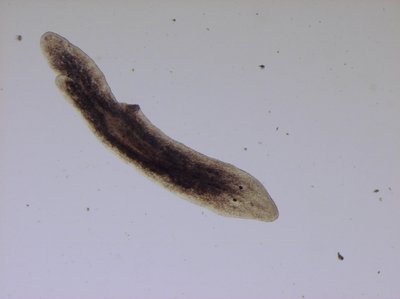Flatworms
Comparative studies on the regenerative capacity of free-living flatworms in Tyrol
Since many years, free-living flatworms ("Turbellaria", Plathelminthes) are in the focus of research in developmental biology. This animal group is characterized by a pronounced regeneration capacity, facilitated by a likely totipotent stem cell system even in adults. Many flatworms are able to regenerate a complete animal - even the head - from tiny tissue fragments, which led previous researchers to call them "immortal under the blade of the knife".
However, not all free-living flatworms can regenerate equally well and some can't regenerate at all. Only in a few taxa of flatworms the regeneration capacity was documented properly, in many taxa there are no or insufficient studies. A systematic comparison of the regeneration capacity within different taxa of flatworms is necessary to shed light on the ancestral condition - is the pronounced regeneration capacity of some flatworms a primitive character of the Plathelminthes or has it evolved independently several times in this taxon? What is the adpative value of regeneration and what is the interrelation between asexual reproduction and regeneration capacity? And finally, why can some animals regenerate and others cannot?
Since the 1920s research on flatworms was conducted at the University of Innsbruck - but mainly with marine species, many of which have been discovered and described by renowned researchers such as Otto Steinböck and Reinhard Rieger. On the other hand, the Tyrolean flatworm fauna has never been systematically described. Sampling of flatworms in Tyrolean waters and concurrent dermination of the water quality will elucidate the zoogeographical distribution of free-living flatworms and also enable comparative regeneration studies with the collected species.
Scientists at the University of Innsbruck together with pupils of the Praxisvolksschule Tirol will search for Tyrolean flatworms; under guidance of the researchers, each child will perform regeneration experiments with the flatworms it collected itself and it will follow and document the regeneration process.
This project is already completed.
Publikation
-
In: Developmental Biology 357. pp. 117-132
-
MARTIN-DURAN, J.M/EGGER, B. (2012): Developmental diversity in free-living flatworms. (Opens in new window)In: EvoDevo, 3:7 (PDF, 7 MB)
-
In: Development Genes and Evolution 219. pp. 409-417
-
In: Frontiers in Zoology, 10:64.
-
In: Methods in Cell Biology 96. pp. 307-330
-
In: EvoDevo, 4:29.
-
In: EvoDevo, 5:37.
-
DIRKS, U. et.al. (2012): : Proliferation pattern during rostrum regeneration of the symbiotic flatworm Paracatenula galateia: a pulse-chase-pulse analysis. (Opens in new window)In: Cell and Tissue Research, doi:10.1007/s00441-012-1426-4 (PDF, 711 KB)
-
doi:10.1080/07924259.2011.611825
Bakkalaureatsarbeit
-
Universität Innsbruck, Institut für Zoologie, Innsbruck 2010
-
Universität Innsbruck, Institut für Zoologie, Innsbruck 2010
-
Universität Innsbruck, Institut für Zoologie, Innsbruck 2010
-
Universität Innsbruck, Institut für Zoologie, Innsbruck 2009
-
Universität Innsbruck, Institut für Zoologie, Innsbruck 2010
-
Universität Innsbruck, Institut für Zoologie, Innsbruck 2010

